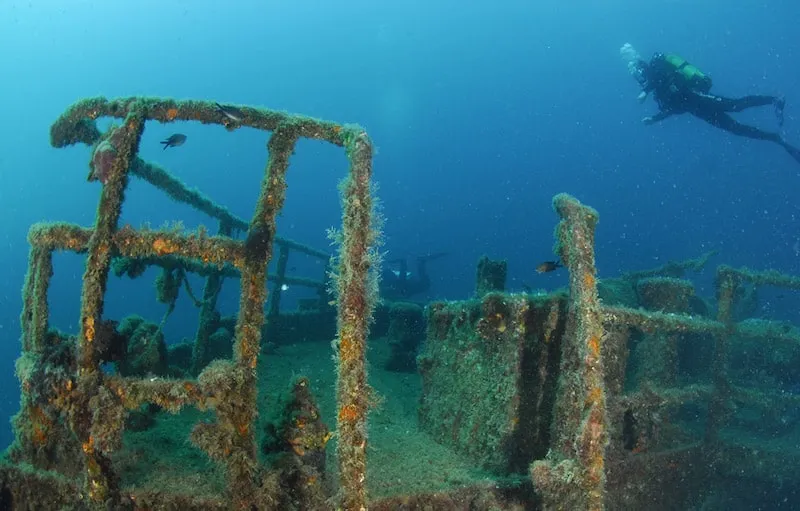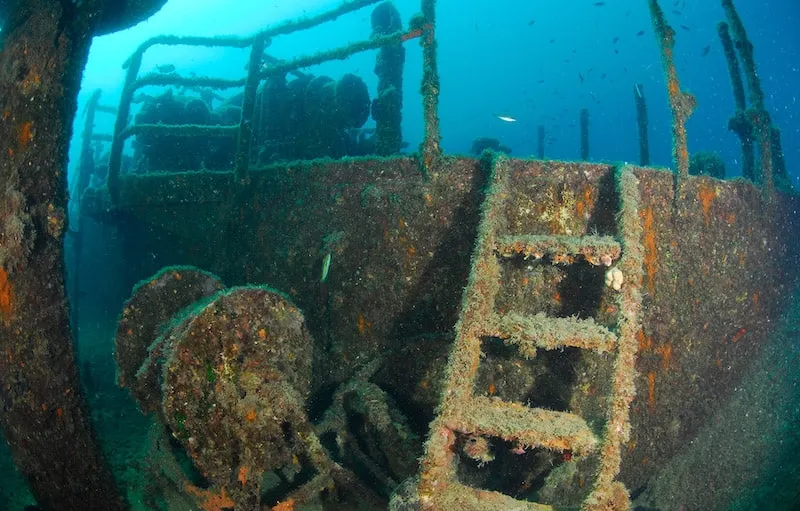Diving the Peltastis Wreck: A Detailed Guide for Underwater Explorers
Table of Contents
The Adriatic Sea, with its rich maritime history, is home to numerous shipwrecks that tell tales of ancient trade, naval battles, and maritime disasters. Among these underwater treasures is the Peltastis wreck, located near the Croatian island of Krk. This well-preserved shipwreck offers a fascinating glimpse into maritime history, attracting archaeologists, divers, and historians alike.
In this article we explore the history of the Peltastis wreck, its discovery, archaeological significance, and what makes it a unique underwater site. Additionally, we will discuss diving conditions, preservation efforts, and the broader context of shipwrecks in the Adriatic.
Historical Background of the Peltastis
The Ship’s Origins
The ship now known as Peltastis was built at the Kremer Sohn shipyard in northern Germany and launched into the sea in late 1952. By early 1953, it was delivered to its first owner – the company P/R Alsterpark from Hamburg, after which it was originally named Alsterpark.
It was a small cargo motor vessel, weighing 874 tons and measuring just over 60 meters in length, primarily intended for coastal navigation. After fourteen years in service, in 1967, the ship changed hands. Its new owner became the Greek company CHR M. Sarlis & Co. from Piraeus, which renamed it Peltastis. However, the ship did not remain long in operation under its new ownership.
The Final Voyage and Sinking
On the night of January 8, 1968, one of the greatest maritime tragedies in this region occurred. At 3:50 a.m., the ship Peltastis sank approximately halfway between Šilo and Klimno, taking with it seven crew members and Captain Theodoros Belesis.
Discovery of the Wreck
Initial Findings
The ship’s exact location was not widely publicized initially to prevent looting and unauthorized salvage operations. Over time, however, the site became known among diving enthusiasts and marine archaeologists.
Archaeological Exploration
The first official archaeological surveys of the wreck were conducted in the early 2000s by Croatian maritime archaeologists. Using sonar scanning and underwater photography, researchers mapped the wreck and documented its condition. The findings confirmed that the ship was largely intact, lying on its starboard side at a depth of approximately 30 to 40 meters (98 to 131 feet).
Diving the Peltastis Wreck
1. Location and Depth
- GPS Coordinates: Approximately 45°06’N, 14°32’E (exact location often kept discreet to prevent unauthorized dives).
- Depth Range:
- Shallowest point (deck): ~28 meters (92 ft)
- Deepest point (seabed near the stern): ~40 meters (131 ft)
- Shallowest point (deck): ~28 meters (92 ft)
- Bottom Composition: Sandy and rocky seabed with occasional patches of seagrass.

Due to its depth, the Peltastis is classified as an advanced-level dive, requiring Deep Diver certification or equivalent experience.
2. Visibility and Water Temperature
- Visibility: Typically 10–20 meters (33–66 ft), with the best conditions in summer and early autumn. Winter months may see visibility drop to 5–10 meters due to plankton blooms.
- Water Temperature:
- Summer (June–September): 20–26°C (68–79°F) – wetsuit (5–7mm) or semi-dry suit recommended.
- Winter (November–March): 12–15°C (54–59°F) – dry suit strongly advised.
- Summer (June–September): 20–26°C (68–79°F) – wetsuit (5–7mm) or semi-dry suit recommended.
3. Currents and Dive Difficulty
- Currents: Generally mild to moderate, but unpredictable surges can occur, especially near the wreck’s openings.
- Difficulty Level:
- Intermediate-Advanced (due to depth and potential currents).
- Not recommended for beginners due to decompression risks.
- Intermediate-Advanced (due to depth and potential currents).
4. Descent and Entry Points
Most dives start from a boat mooring directly above the wreck. A shot line is often used for safe descent, especially in low visibility.
Descent:
- Follow the anchor line to avoid disorientation.
- First stop at ~15 meters (50 ft) for a quick team check.
- Proceed slowly to the wreck at ~30 meters (98 ft).
5. Navigating the Wreck
The Peltastis lies on its starboard side, allowing divers to explore:
The Bow Section
- Notable Features:
- Anchor chain still visible, partially buried in the sand.
- Hull plates covered in sponges and soft corals.
- Anchor chain still visible, partially buried in the sand.
- Marine Life: Often home to conger eels and scorpionfish.

The Cargo Holds
- Partially collapsed, allowing limited penetration (only for trained wreck divers).
- Artifacts: Occasionally, ceramic shards or metal fragments can be seen.
The Engine Room
- Steam machinery is still recognizable, though heavily encrusted.
- Caution: Sharp edges and potential silt-out risk if disturbed.
The Stern and Propeller
- The propeller is partially buried, but one blade is usually visible.
- Marine Life Hotspot: Groupers, moray eels, and octopuses frequent this area.
6. Ascent and Safety Stops
- Maximum Bottom Time: ~20–25 minutes (due to depth).
- Mandatory Safety Stop: 3 minutes at 5 meters (16 ft) (longer if close to no-decompression limits).
- Exit: Ascend via the mooring line to avoid drift.
Marine Life at the Peltastis Wreck
The wreck acts as an artificial reef, attracting a variety of Adriatic species:
Common Fish Species
- Groupers (Epinephelus marginatus) – Often seen near the propeller.
- Moray Eels (Muraena helena) – Hide in crevices.
- Scorpionfish (Scorpaena scrofa) – Camouflaged on the wreck.
- Damselfish (Chromis chromis) – School around the structure.

Invertebrates and Coral Growth
- Sponges (Axinella polypoides) – Cover large sections of the hull.
- Soft Corals (Alcyonacea) – Add color to the metal surfaces.
- Octopuses (Octopus vulgaris) – Frequently spotted in small holes.
Seasonal Visitors
- Summer: More pelagic species like barracudas and amberjacks.
- Winter: Larger conger eels become more active.
Safety Considerations and Risks
1. Depth-Related Hazards
- Nitrogen Narcosis: Likely at 30+ meters—stay calm and ascend slightly if symptoms appear.
- Decompression Sickness (DCS):
- Strictly monitor no-deco limits (use a dive computer).
- Consider a nitrox mix (32%) to extend bottom time safely.
- Strictly monitor no-deco limits (use a dive computer).
2. Wreck-Specific Risks
- Entanglement: Fishing nets and lines sometimes snag on the wreck.
- Silt-Outs: Avoid excessive finning near the cargo holds.
- Limited Visibility Inside: Penetration dives require proper training and a guideline reel.
3. Emergency Procedures
- Lost Buddy: Agree on a pre-dive separation plan (e.g., return to the anchor line).
- Equipment Failure: Signal the dive leader and make a controlled ascent.
Booking and Costs
- Price Range: ~€70–€100 per dive (includes tank, weights, guide).
- Requirements:
- Advanced Open Water certification (or equivalent).
- Proof of deep diving experience (some operators require a check dive).
- Advanced Open Water certification (or equivalent).
When to Go
- Best Season: from June to October (calm seas, warm water).
- Avoid: Winter months (rough conditions, colder temps).
Is the Peltastis Worth Diving?
Absolutely—if you’re an experienced diver. The wreck offers:
- A well-preserved historical artifact.
- Thrilling deep-wreck exploration.
- Vibrant marine life encounters.
However, due to its depth and potential hazards, proper training and preparation are essential. For those ready for the challenge, the Peltastis wreck is one of the Adriatic’s most rewarding dives.
Final Tips for Divers
- Dive with a guide (local knowledge is invaluable).
- Use a dive computer (track depth and no-deco time).
- Bring a torch (even in daylight, it helps see into crevices).
- Respect the wreck (no artifact removal).
You can read more about scuba diving on Krk HERE, and If you need help organising your activities or booking the best tours to explore the island and it’s surrounding, feel free to contact us. If you need a place to stay, check out our selection of accommodation on the island of Krk.